I want to be able to cast like that!
There are a lot of fish in the sea, which I found out firsthand recently on a guided trip with Greasy Beaks Flyfishing.
I witnessed multiple species of marine life, several of which I had never seen outside of a dinner plate or Wikipedia. In addition to landing striped bass on the fly, there were also catches of cod and pogies (also known as bunker or menhaden).
Lastly, we saw some larger ocean inhabitants: Atlantic sturgeon, a harbor seal, and even a surfacing minke whale! The number of species we saw and caught that day surprised me. While not all of them were your usual saltwater gamefish, such as tuna, bluefish, fluke, or black seabass, and though they weren’t all caught on a fly rod, all of the species stumbled upon brought joy to someone who’s not used to venturing offshore.
Captain Eliot Jenkins of Greasy Beaks Flyfishing is arguably one of the best guides in the world for targeting wild saltwater striped bass on the fly (yes, there are both freshwater and stocked striped bass across the lower 48).
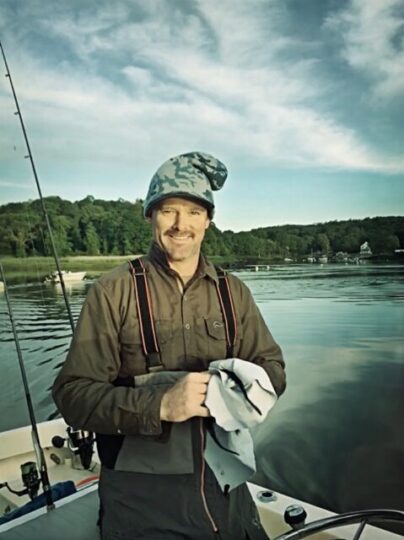
If going after striped bass and false albacore in a 23-foot Parker center-console boat isn’t your thing, Eliot also guides for steelhead in both New York and Oregon. He is Orvis-endorsed and also maintains one of the Orvis.com fishing reports for the North Shore of Massachusetts. Eliot is full of energy, takes care of his clients, and is a responsible steward of his fishery.
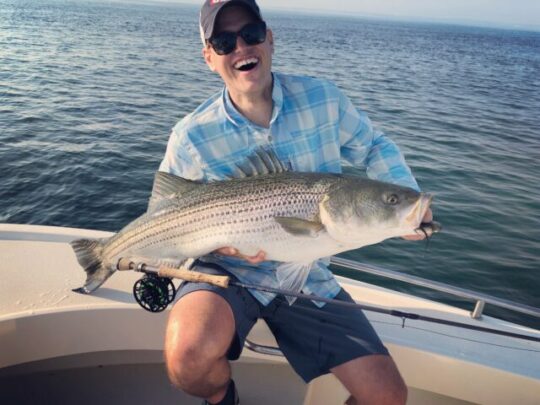
Going out for a half, three-quarter, or full day with an Orvis-endorsed guide is a real treat, and I’ve had nothing but good experiences with them. Like Eliot, any Orvis-endorsed guide will be knowledgeable about all the aquatic life in their local ecosystem, not just the ones you’re casting a fly to. Unexpectedly, it was this knowledge and experience with other fish and animals that I’ll most remember.
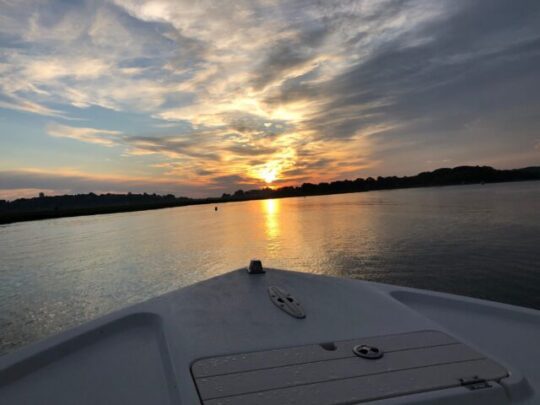
Our weekday excursion began with launching from the Ipswich Town Wharf Ramp, where parking is ample at 5:15 am. We crammed sunscreen, an extra fly rod or two, and Busch Light into the bow hatch and rotor-molded cooler.
On this cloudy morning, all of our action for stripers came from 6 am to 8 am. I cast a borrowed G. Loomis #10 with a 350-grain sinking line, while my father cast a spinning rod with a classic “spook” style surface popper lure.
We both caught fish as we drifted through tidal rips and relished being the only boat on the water, having an entire stretch of choice water to ourselves. To attract attention, Eliot would cast a hookless teaser lure to draw fish towards the boat, after which we would cast beyond. Sure enough, the large white baitfish fly pattern that I used enticed several schoolies, with a couple being decent sized in the mid-20-inch range.
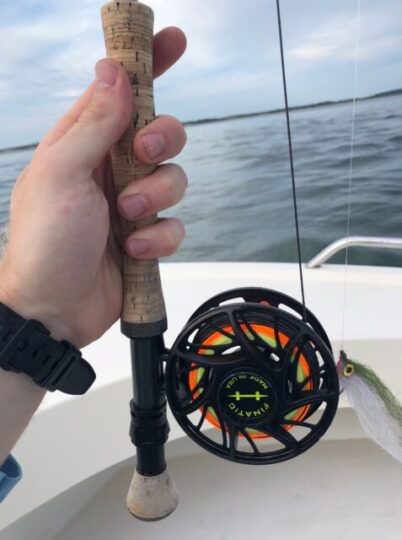
All fish were safely and quickly released and would have been even if they had been “slot-sized” (28 to 35 inches). These days, an Instagram photo is way cooler than “suzuki” sushi in the fridge. Personally, I’m committed to protecting the population of wild striped bass on the East Coast by advocating for their treatment as a gamefish, supporting organizations like Stripers Forever, and not eating them at restaurants.
We changed locations, and the species count began to increase. We had already seen Atlantic sturgeon jumping in the distance. These “living fossils” are heavily protected and rarely seen up close, except for the large splashes when they breach. One theory behind their love of jumping is that they’re actively trying to dislodge parasites. They are found in less than two dozen areas on the East Coast of the United States according to NOAA.
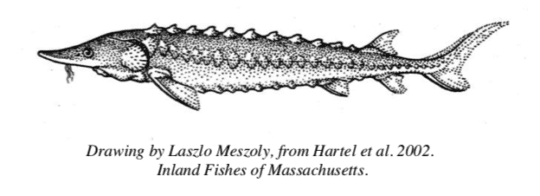
Motoring north, we encountered schools of menhaden. Locally called pogies, but better known as bunker, these 14-inch fish are a popular bait for enticing large striped bass to eat. My jaw dropped at the sizes of these schools. They were right at the surface, thousands of them, with fins breaking the water.
While we didn’t see any “cows” (large female stripers) this time, the memory of this biomass stays with me. There were multiple schools of pogies in giant spirals, ambling along the shore of Plum Island. While a fleet of anglers followed them, the action on this day was slow.
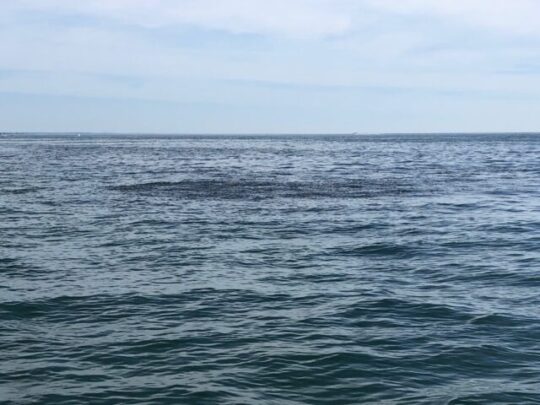
En route to a new spot, we spotted a seal, and Eliot saw a minke whale breaking the surface in the distance. We continued on our big-fish hunt by venturing into deeper water and looking for schools of mackerel, but instead hooked a cod. Coming face to face with “the fish that changed the world” for the first time in my life was awesome.
We eventually headed back towards the Ipswich River. Unable to move any of the striped bass resting on the bottom with a large Chocklett’s Game Changer fly, we called it a day and headed in.
If you’ve never spent a day with an Orvis-endorsed guide, I highly recommend it. Not only will you find fish, you’ll also get a casting lesson while using high-end tackle. To maximize your enjoyment on a trip like this:
- Practice your casting with heavy rods and lines. If you’ve never cast 30 feet of 350-grain sinking line with a #10 rod, you’re in for a surprise. While not all fish hooked on the fly necessarily eat far away from the boat, it helps to be able to cast 50 to 75 feet with a heavy rig. Casting sinking line is easier when elevated and standing on the prow of a powerboat than it is while wading, so don’t get discouraged if your practice sessions are frustrating.
- Don’t just listen to your guide, take drastic action when they counsel you. I didn’t catch a fish that morning until I made an adjustment in casting direction once my sleep-deprived brain finally processed Eliot’s instructions.
- Communicate what your goals and desires are for the day early on, or just go with the flow. If you’re not interested in fishing with conventional or spinning tackle no matter what the conditions, tell your guide, it won’t be a problem. Otherwise, put your trust in your guide to adapt your fishing techniques to the conditions and fish behavior on that day.
I hope that my next saltwater species on the fly will be false albacore this fall. But, until then, I’m grateful for the multitude of species that I encountered during this summer morning on the cold waters of the Atlantic.
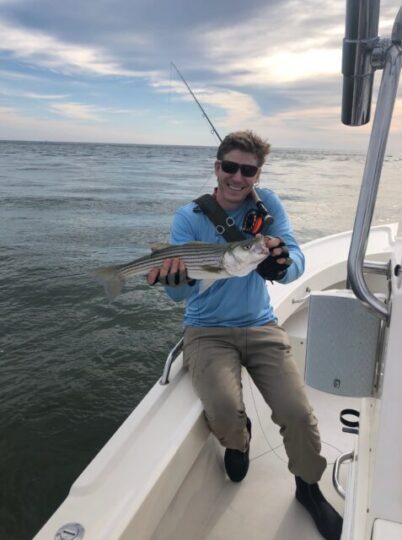
Discover more from BlogFlyFish.com
Subscribe to get the latest posts sent to your email.

Wow, that area you fished brings back memories. I grew up a few minutes south from that area. A good friend of mine who moored his boat at Ipswich bay yacht club and I fished stripers in the mouth of the Ipswich as well as the parker and Merrimac rivers. A lot of time spent catching schoolies in Ipswich bay which generally are not giants, but extremely fun to catch.
The Ipswich river farther up stream in the more unfortunately heavily populated sections was known for decent trout fishing. Though some if you knew where to look, not a lot of access points back then, and I’m sure 20 years+ later, probably even less.
Sounds like a nice time….Phil Carroll
Hi Phil. Very cool! Yes, the Ipswich is stocked further upriver, and still very fishy by the mouth. Glad you liked the post. Thanks, Dave